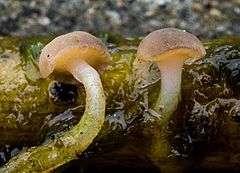Cudoniella clavus
| Cudoniella clavus | |
|---|---|
 | |
| Scientific classification | |
| Kingdom: | Fungi |
| Division: | Ascomycota |
| Class: | Leotiomycetes |
| Order: | Helotiales |
| Family: | Helotiaceae |
| Genus: | Cudoniella |
| Species: | C. clavus |
| Binomial name | |
| Cudoniella clavus (Alb. & Schwein.) Dennis (1964) | |
| Synonyms[1] | |
Cudoniella clavus is a species of fungus in the family Helotiaceae. It was first described in 1805 by Johannes Baptista von Albertini and Lewis David de Schweinitz as Peziza clavus. British mycologist R. W. G. Dennis transferred it to Cudoniella in 1964.[2] Fruit bodies of the fungus consist of a disc-like cap measuring 0.4–1.2 cm (0.16–0.47 in) with a thin stipe. They grow on rotting twigs, stems, leaves, and cones that are submerged in water. Cudoniella clavus is a widespread and common species.[3]
References
- ↑ "Cudoniella clavus (Alb. & Schwein.) Dennis". MycoBank. International Mycological Association. Retrieved 2014-07-14.
- ↑ Dennis RWG (1964). "Remarks on the genus Hymenoscyphus S.F.Gray, with observations on sundry species referred by Saccardo and others to the genera Helotium, Pezizella or Phialea". Persoonia. 3 (1): 29–80 (see p. 73).
- ↑ Beug MW, Bessette AE, Bessette AR (2014). Ascomycete Fungi of North America: A Mushroom Reference Guide. Texas: University of Texas Press. p. 671. ISBN 978-0-292-75452-2.
External links
This article is issued from Wikipedia - version of the 11/25/2016. The text is available under the Creative Commons Attribution/Share Alike but additional terms may apply for the media files.